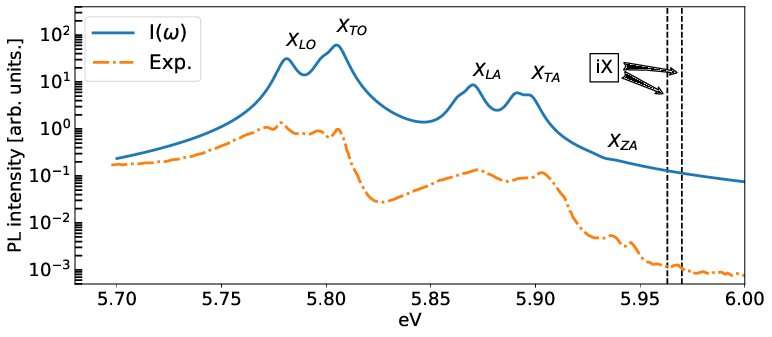Coupling excitons and phonons in hexagonal boron nitride

In standard solid state physics textbooks direct band gap semiconductorsare considered efficient light emitters while indirect ones are regarded as inefficient. Siliconis a typical example: its indirect nature prohibits applications in optoelectronics. This facthas motivated significant research activity to engineer silicon and transform it into a direct gap semiconductor by means of defects, nanostructuring, etc.
A more recent and remarkableexample of indirect to direct gap transition is represented by MoS2 nanostructuring. Theluminescence signal increases by four orders of magnitude passing from multi-layer to singlelayer MoS2 with an associated indirect to direct band gap transition.Hexagonal boron nitride (h-BN) seems to defy this rule: it has a large indirect band gap ofabout 7 eV, but it has recently attracted much attention from the scientific community as avery efficient light emitter in the ultraviolet3.
An internal quantum yield of'45% has beenreported forh-BN, much closer to the'50% one of ZnO (direct band gap) than to the 0.1%one of diamond (indirect band gap)4. This goes against the common wisdom that indirect band gap insulators are bad light emitters and in fact the strong luminescence signal wasinitially attributed to direct exciton recombination. In this work we study phonon-assisted luminescence by means of a newly derived approach that include the coupling between excitons and phonons.
We found that luminescence inh-BN is dominated by phonon-assisted transitions and that strong exciton-phonon coupling leads to its intensity being unexpectedly large and comparable to that of direct bandgap materials. This open the possiblity to use this materals as light emitter in the ultra-vialet.
More information:
E. Cannuccia et al. Theory of phonon-assisted luminescence in solids: Application to hexagonal boron nitride, Physical Review B (2019). DOI: 10.1103/PhysRevB.99.081109
Provided by CNRS